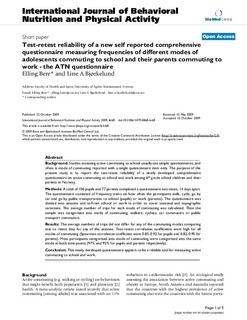| dc.contributor.author | Bere, Elling | |
| dc.contributor.author | Bjørkelund, Line Anita | |
| dc.date.accessioned | 2010-01-07T15:42:41Z | |
| dc.date.issued | 2009 | |
| dc.identifier.citation | Bere, E., & Bjorkelund, L. A. (2009). Test-retest reliability of a new self reported comprehensive questionnaire measuring frequencies of different modes of adolescents commuting to school and their parents commuting to work - the ATN questionnaire. [Article]. International Journal of Behavioral Nutrition and Physical Activity, 6. doi: 10.1186/1479-5868-6-68 | en |
| dc.identifier.issn | 1479-5868 | |
| dc.identifier.uri | http://hdl.handle.net/11250/138970 | |
| dc.description | Published version of an article from the journal: International Journal of Behavioral Nutrition and Physical Activity
Article available from: http://www.ijbnpa.org/content/6/1/68 | en |
| dc.description.abstract | Background: Studies assessing active commuting to school usually use simple questionnaires, and often is mode of commuting reported with a single questionnaire item only. The purpose of the present study is to report the test-retest reliability of a newly developed comprehensive questionnaire on active commuting to school and work among 6thgrade school children and their parents in Norway. Methods: A total of 106 pupils and 77 parents completed a questionnaire two times, 14 days apart. The questionnaire consisted of frequency items on how often the participants walk, cycle, go by car and go by public transportation to school (pupils) or work (parents). The questionnaire was divided into seasons and to/from school or work in order to cover seasonal and topographic variations. The average number of trips for each mode of commuting was calculated. Then the sample was categorised into mode of commuting: walkers, cyclists, car commuters or public transport commuters. Results: The average numbers of trips did not differ for any of the commuting modes comparing test to retest data for any of the seasons. Test-retest correlation coefficients were high for all modes of commuting (Spearman correlation coefficient were 0.85-0.92 for pupils and 0.82-0.95 for parents). Most participants categorised into mode of commuting were categorized into the same mode at both time points (97% and 95% for pupils and parents respectively). Conclusion: This newly developed questionnaire appears to be a reliable tool for measuring active commuting to school and work. © 2009 Bere and Bjørkelund; licensee BioMed Central Ltd. | en |
| dc.format.extent | 199021 bytes | |
| dc.format.mimetype | application/pdf | |
| dc.language.iso | eng | en |
| dc.publisher | BioMed Central | en |
| dc.title | Test-retest reliability of a new self reported comprehensive questionnaire measuring frequencies of different modes of adolescents commuting to school and their parents commuting to work - The ATN questionnaire | en |
| dc.type | Journal article | en |
| dc.type | Peer reviewed | en |
| dc.subject.nsi | VDP::Medical disciplines: 700::Health sciences: 800::Preventive medicine: 804 | en |
| dc.subject.nsi | VDP::Medical disciplines: 700::Sports medicine: 850 | en |
| dc.source.pagenumber | 1-5 | en |
| dc.source.volume | 6 | en |
| dc.source.journal | International Journal of Behavioral Nutrition and Physical Activity | en |
| dc.source.issue | 68 | en |

